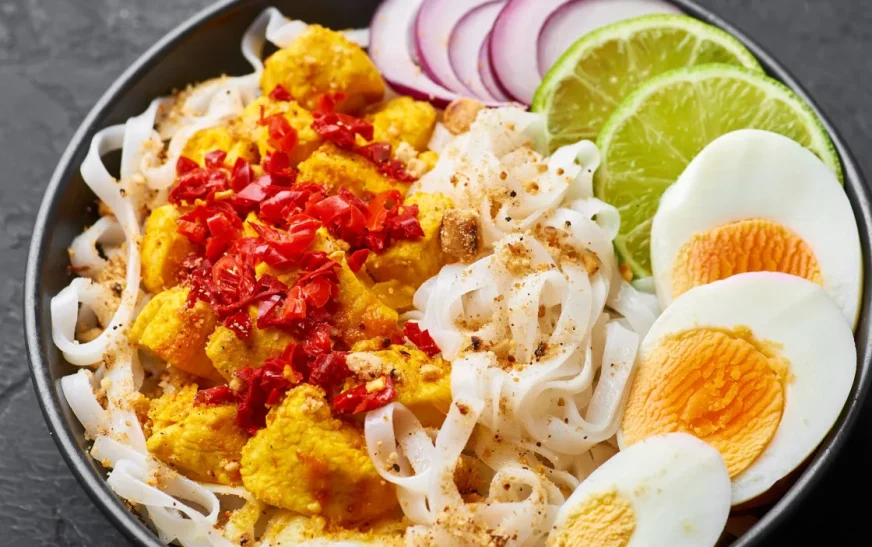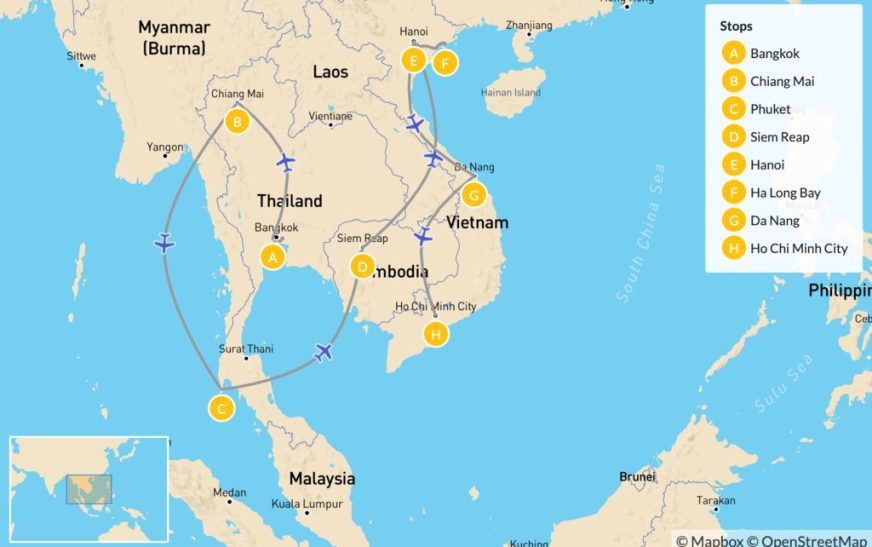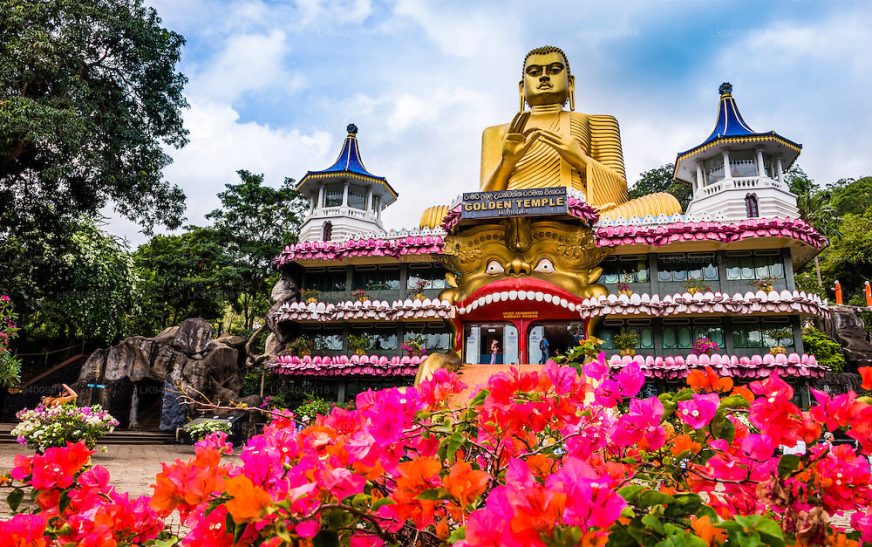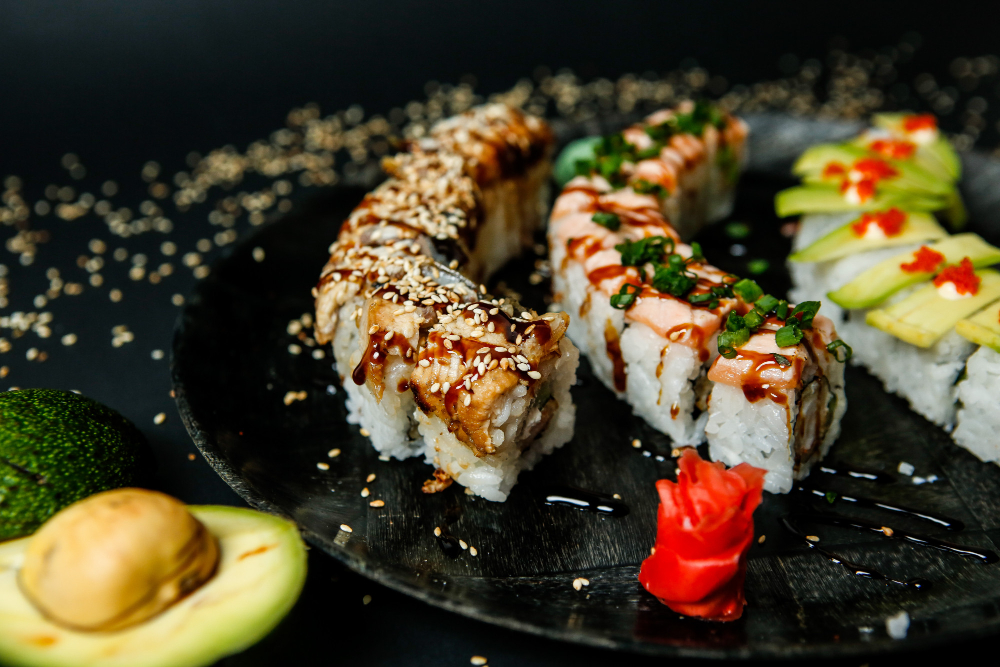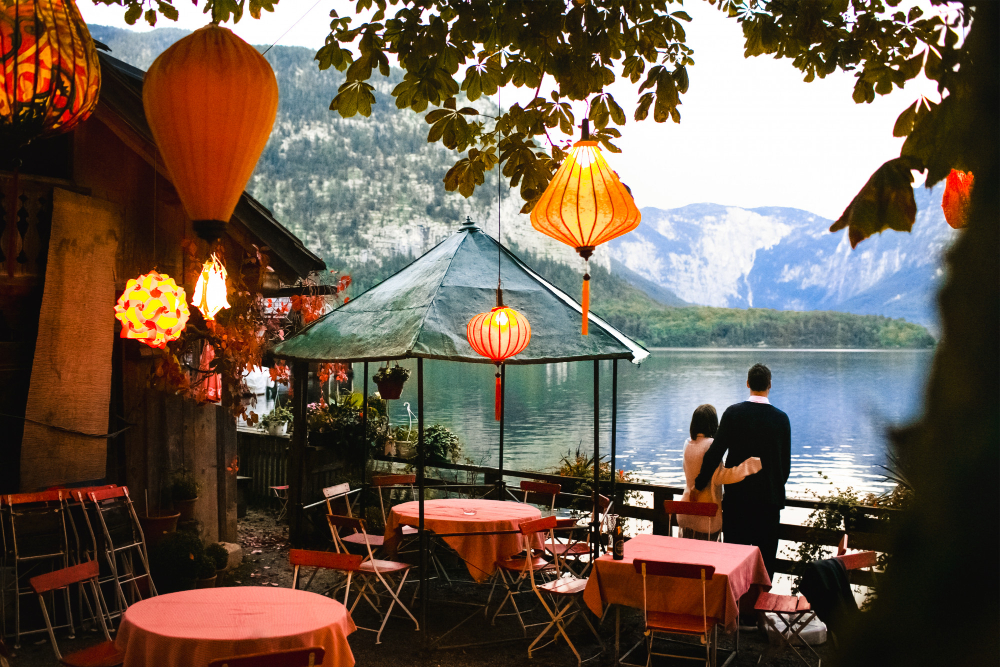Food from Myanmar: Myanmar, formerly known as Burma, offers a rich tapestry of culinary delights influenced by its diverse ethnic groups and neighboring countries. From vibrant street food to flavorful traditional dishes, Myanmar’s cuisine is as varied as its culture. If you’re planning a trip or simply curious about this Southeast Asian country’s food, here are ten essential dishes you must try to truly experience the flavors of Myanmar.
Food from Myanmar: Mohinga-The National Dish of Myanmar
Mohinga is often considered Myanmar’s national dish, and for good reason. This hearty soup, typically enjoyed for breakfast, features a rich, fish-based broth flavored with lemongrass, ginger, and garlic. The dish is usually served with rice noodles, and topped with crispy fritters, boiled eggs, and fresh cilantro.
The depth of flavor in Mohinga comes from the use of fish paste and a variety of aromatic spices. It’s a comforting and satisfying dish that perfectly captures the essence of Myanmar’s cuisine. Whether enjoyed at a local street stall or in a more formal setting, Mohinga is a must-try for any food enthusiast.
Food from Myanmar: Laphet Thoke-Fermented Tea Leaf Salad
Laphet Thoke is a unique and beloved dish in Myanmar, known for its distinctive combination of flavors and textures. The key ingredient is fermented tea leaves, which are mixed with a variety of ingredients such as peanuts, sesame seeds, fried garlic, and fresh vegetables like tomatoes and lettuce.
This salad is a perfect example of Myanmar’s culinary creativity. The fermented tea leaves provide a tangy and slightly bitter taste, which is balanced by the crunchiness of the nuts and the freshness of the vegetables. Laphet Thoke is often served as an appetizer or a side dish and is a great way to start a meal.
Shan Noodles: A Taste of Myanmar’s Shan State
Originating from the Shan State in Myanmar, Shan Noodles are a popular dish known for their simplicity and deliciousness. This dish consists of rice noodles served in a savory broth made from chicken or pork, and is typically garnished with pickled vegetables, fresh herbs, and sometimes a sprinkling of ground peanuts.
Shan Noodles are a testament to the flavors of Myanmar’s northern region, where the use of fresh ingredients and aromatic spices is key. The dish is both comforting and flavorful, making it a favorite among locals and visitors alike.
Ohn No Khao Swe: Coconut Curry Noodles
Ohn No Khao Swe is a rich and creamy noodle soup that combines the flavors of coconut milk and curry. This dish features egg noodles served in a fragrant coconut-based curry broth, and is often topped with crispy fried onions, boiled eggs, and fresh cilantro.
The use of coconut milk in Ohn No Khao Swe gives it a luxurious texture and a subtly sweet flavor that complements the spiciness of the curry. This dish is particularly popular during colder months or when seeking a comforting, hearty meal.
Kaukswe: Myanmar’s Traditional Rice and Curry Dish
Kaukswe is a traditional Myanmar dish that consists of rice served with a variety of curries. Unlike other Southeast Asian curries, Myanmar curries are typically less spicy but are rich in flavor thanks to the use of ingredients like turmeric, ginger, and garlic.
The curries can vary from chicken and pork to vegetarian options, and are often accompanied by side dishes such as pickled vegetables and a fresh salad. Kaukswe is a versatile and satisfying dish that showcases the rich culinary traditions of Myanmar.
Food from Myanmar: Burmese Style Grilled Fish-A Flavorful Delight
Burmese Style Grilled Fish is a popular dish that highlights Myanmar’s love for fresh seafood. The fish is typically marinated in a mixture of turmeric, garlic, and other spices, then grilled to perfection. The result is a flavorful and aromatic dish with a crispy exterior and tender, flaky flesh.
Often served with a side of steamed rice and a tangy dipping sauce, this dish is a great way to enjoy the fresh flavors of Myanmar’s coastal regions. It’s a simple yet delicious example of the country’s seafood offerings.
Samosa Salad: A Unique Fusion Dish
Samosa Salad is a delightful fusion dish that combines the flavors of traditional Indian samosas with Myanmar’s fresh ingredients. The salad features chopped samosas mixed with fresh vegetables, herbs, and a tangy dressing.
This dish is a great way to experience the blend of cultural influences in Myanmar’s cuisine. The crispy samosas add texture and flavor to the salad, making it a refreshing and satisfying meal or side dish.
Htamin Jin: Burmese Rice Salad
Htamin Jin is a flavorful rice salad that is often served as a side dish or light meal. The rice is mixed with a variety of ingredients such as pickled vegetables, fresh herbs, and sometimes small pieces of grilled meat or seafood.
The salad is dressed with a tangy sauce made from lime juice, fish sauce, and chili, giving it a vibrant and zesty flavor. Htamin Jin is a versatile dish that can be customized to suit different tastes and is a great example of Myanmar’s creative use of rice.
Nangyi Thoke: Dry Noodle Salad with a Kick
Nangyi Thoke is a dry noodle salad that is popular in Myanmar for its bold flavors and satisfying texture. The dish features thick rice noodles tossed with a spicy sauce made from turmeric, chili, and garlic, and is often garnished with pickled vegetables, boiled eggs, and fresh cilantro.
The combination of spices and the chewy texture of the noodles make Nangyi Thoke a standout dish. It’s often enjoyed as a snack or a light meal and is a great way to experience Myanmar’s love for bold and flavorful cuisine.
Mote Lone Yay Paw: Traditional Burmese Dessert
Mote Lone Yay Paw is a traditional Burmese dessert that is made from glutinous rice flour and palm sugar. The dish features small, chewy rice balls filled with sweet palm sugar syrup, which are then steamed to perfection.
This dessert is often enjoyed as a sweet treat after a meal or during festive occasions. The combination of sweet syrup and chewy rice balls provides a delightful contrast in texture and flavor, making Mote Lone Yay Paw a beloved part of Myanmar’s culinary heritage.
Conclusion
Food from Myanmar: Myanmar’s cuisine is a vibrant and diverse reflection of the country’s rich cultural heritage. From the hearty and comforting Mohinga to the tangy and refreshing Laphet Thoke, each dish offers a unique glimpse into the flavors and traditions of Myanmar. Whether you’re exploring the bustling streets of Yangon or enjoying a quiet meal at home, these ten essential dishes provide a delicious introduction to the country’s culinary landscape.
As you embark on your culinary journey through Myanmar, be sure to sample these must-try dishes to truly appreciate the depth and variety of Burmese cuisine. Each bite is a celebration of Myanmar’s diverse flavors and a testament to its rich food culture.
FAQs
1. What are the key ingredients in Mohinga?
Mohinga typically includes fish, rice noodles, lemongrass, ginger, garlic, and various spices. It is often topped with crispy fritters and boiled eggs.
2. Is Laphet Thoke spicy?
Laphet Thoke is not typically spicy. Its flavor profile is more tangy and savory, with the fermented tea leaves providing a unique taste.
3. Can you find Shan Noodles outside Myanmar?
Shan Noodles can sometimes be found in Burmese restaurants abroad, especially in areas with significant Burmese communities. However, they are most authentic when enjoyed in Myanmar.
4. What is the difference between Ohn No Khao Swe and other noodle soups?
Ohn No Khao Swe is distinguished by its use of coconut milk in the broth, giving it a creamy and slightly sweet flavor that sets it apart from other noodle soups.
5. Are there vegetarian options for Kaukswe?
Yes, Kaukswe can be made with vegetarian curries, using ingredients such as potatoes, chickpeas, and a variety of vegetables, to provide a flavorful alternative to meat-based curries.
Also read: Thailand, Vietnam, and Cambodia Trip: 10 Unforgettable Experiences You Can’t Miss

